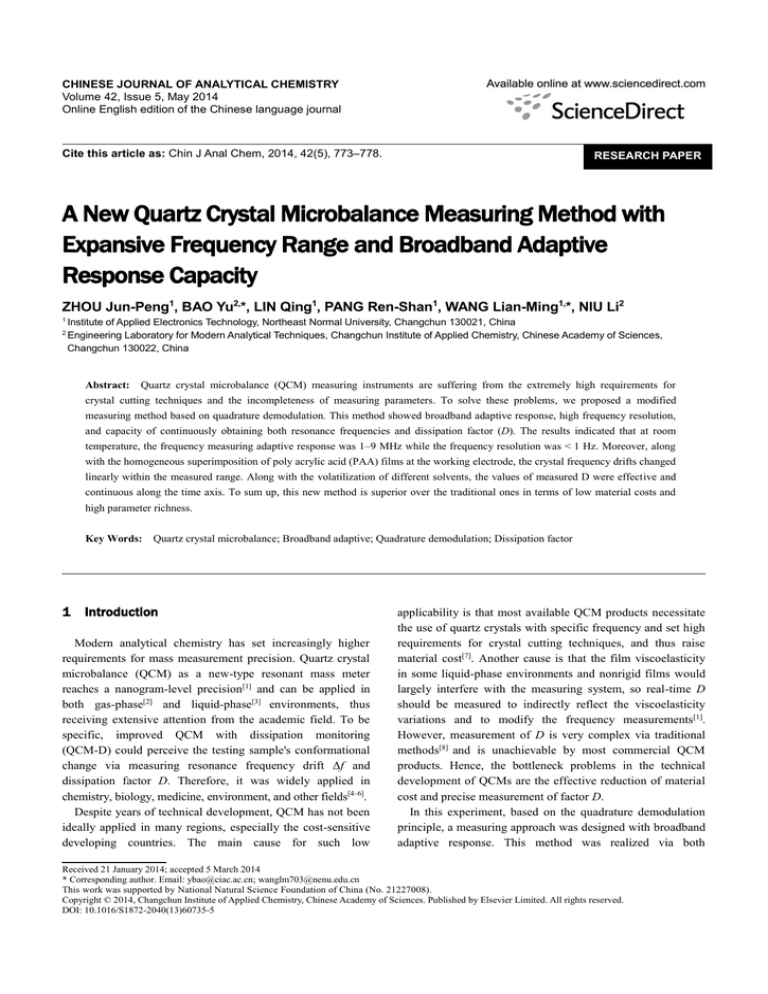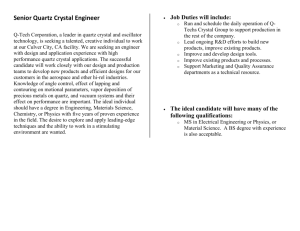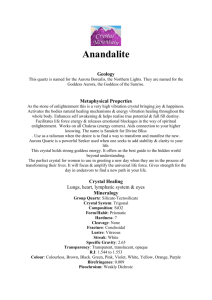
CHINESE JOURNAL OF ANALYTICAL CHEMISTRY
Volume 42, Issue 5, May 2014
Online English edition of the Chinese language journal
Cite this article as: Chin J Anal Chem, 2014, 42(5), 773–778.
RESEARCH PAPER
A New Quartz Crystal Microbalance Measuring Method with
Expansive Frequency Range and Broadband Adaptive
Response Capacity
ZHOU Jun-Peng1, BAO Yu2,*, LIN Qing1, PANG Ren-Shan1, WANG Lian-Ming1,*, NIU Li2
1
2
Institute of Applied Electronics Technology, Northeast Normal University, Changchun 130021, China
Engineering Laboratory for Modern Analytical Techniques, Changchun Institute of Applied Chemistry, Chinese Academy of Sciences,
Changchun 130022, China
Abstract:
Quartz crystal microbalance (QCM) measuring instruments are suffering from the extremely high requirements for
crystal cutting techniques and the incompleteness of measuring parameters. To solve these problems, we proposed a modified
measuring method based on quadrature demodulation. This method showed broadband adaptive response, high frequency resolution,
and capacity of continuously obtaining both resonance frequencies and dissipation factor (D). The results indicated that at room
temperature, the frequency measuring adaptive response was 1–9 MHz while the frequency resolution was < 1 Hz. Moreover, along
with the homogeneous superimposition of poly acrylic acid (PAA) films at the working electrode, the crystal frequency drifts changed
linearly within the measured range. Along with the volatilization of different solvents, the values of measured D were effective and
continuous along the time axis. To sum up, this new method is superior over the traditional ones in terms of low material costs and
high parameter richness.
Key Words:
1
Quartz crystal microbalance; Broadband adaptive; Quadrature demodulation; Dissipation factor
Introduction
Modern analytical chemistry has set increasingly higher
requirements for mass measurement precision. Quartz crystal
microbalance (QCM) as a new-type resonant mass meter
reaches a nanogram-level precision[1] and can be applied in
both gas-phase[2] and liquid-phase[3] environments, thus
receiving extensive attention from the academic field. To be
specific, improved QCM with dissipation monitoring
(QCM-D) could perceive the testing sample's conformational
change via measuring resonance frequency drift Δf and
dissipation factor D. Therefore, it was widely applied in
chemistry, biology, medicine, environment, and other fields[4–6].
Despite years of technical development, QCM has not been
ideally applied in many regions, especially the cost-sensitive
developing countries. The main cause for such low
applicability is that most available QCM products necessitate
the use of quartz crystals with specific frequency and set high
requirements for crystal cutting techniques, and thus raise
material cost[7]. Another cause is that the film viscoelasticity
in some liquid-phase environments and nonrigid films would
largely interfere with the measuring system, so real-time D
should be measured to indirectly reflect the viscoelasticity
variations and to modify the frequency measurements[1].
However, measurement of D is very complex via traditional
methods[8] and is unachievable by most commercial QCM
products. Hence, the bottleneck problems in the technical
development of QCMs are the effective reduction of material
cost and precise measurement of factor D.
In this experiment, based on the quadrature demodulation
principle, a measuring approach was designed with broadband
adaptive response. This method was realized via both
Received 21 January 2014; accepted 5 March 2014
* Corresponding author. Email: ybao@ciac.ac.cn; wanglm703@nenu.edu.cn
This work was supported by National Natural Science Foundation of China (No. 21227008).
Copyright © 2014, Changchun Institute of Applied Chemistry, Chinese Academy of Sciences. Published by Elsevier Limited. All rights reserved.
DOI: 10.1016/S1872-2040(13)60735-5
ZHOU Jun-Peng et al. / Chinese Journal of Analytical Chemistry, 2014, 42(5): 773–778
simulation and hardware circuit construction. The results
show that this method can automatically match the cut-formed
quartz crystals within certain frequency range (1‒9 MHz) and
thus lower the requirements for crystal cutting techniques.
Moreover, it can precisely measure the crystal resonance
frequencies and obtain the current-state D simultaneously, and
thus improve the QCM measurement technique.
2 Measuring principle
2.1
Quartz crystal equivalent circuit model
The theoretical basis for QCM measurement is quartz
crystal electrical circuit models, among which the
Butterworth-van Dyke (BVD) model is generally applied, as
shown in Fig.1a[9]. The followed Fig.1b shows the fitting
curve of the equivalent impedance modulus |Z| of an 8 MHz
quartz crystal via AT cutting. Theoretically, the variations of
the physical properties on crystal surface could induce the
drifts of resonance frequency points (series point fs and
parallel point fp, as shown in Fig.1b)[9], which were generally
expressed by the changes of the 4 equivalent parameters in the
BVD model. In practice, the general working steps of QCM is
as follows. Firstly, it records the frequency point drifts Δf of
quartz crystals at both the initial state and the working state
(Δfs or Δfp, mainly Δfs); then, equations like Sauerbrey[10] or
Kanazawa-Gordon[3] expressions are selected depending on
the type of the testing material; lastly, the relationships of Δf
are quantified with deposit mass Δm or liquid viscosity ηl to
finish the measurement.
2.2
Measuring method
Fig.1
The working principle of the quadrature demodulation is
shown in Fig.2. In this way, the quartz crystal is regarded as a
two-port network and stimulated by a cosine signal Acos(ωt)
with vibration amplitude A and angular frequency ω. Because
both the impedance and the phase of the QCM network will
directly change with the variation of the excitation frequency
ω, the vibration amplitude and the phase of the followed
output signal H(ωt) will also vary from the excitation signal
Acos(ωt). To quantify the changes, we use Pv(ω) to express
the vibration amplitude ratio of output and input signals (0<
Pv(ω) < 1) and φ(ω) to express the phase shift (‒π ≤ φ(ω) ≤ π),
so H(ωt) can be expressed as follows:
H(ωt) = Pv(ω) × Acos[ωt – φ(ω)]
(1)
Then, H(ωt) is multiplied by two quadrature excitation signals,
Acos(ωt) and Asin(ωt) respectively, and the product outputs
are filtered by corresponding low-pass filters (LPF).
The LPFs can filter out the high-frequency components
with angular frequency 2ω, whose existence can be examined
by applying the product-to-sum formula to the products.
Therefore, the produced signals I(ω) and Q(ω) are validated to
be irrelevant to the time variable t , as shown in Eqs. (2) and
(3), respectively.
I(ω) = LPF[Acos(ωt) × H(ωt)] = 0.5 × A2Pv(ω)cos[φ(ω)] (2)
Q(ω) = LPF[Acos(ωt) × H(ωt)] = 0.5 × A2Pv(ω)sin[φ(ω)] (3)
Subsequently, signals I(ω) and Q(ω) are converted to
digital signal by analog-to-digital converters (ADC), before
processed by a micro-controller unit (MCU) in which the
vibration amplitude ratio Pv(ω) and phase φ(ω) at the specific
excitation frequency ω are synthesized as Eqs. (4) and (5).
Pv(ω) = 2(I(ω)2 + Q(ω)2)1/2/A2
(4)
φ(ω) = arctan(Q(ω)/I(ω))
(5)
(a) Quartz crystal butterworth-van dyke model and (b) equivalent impedance modulus |Z| of an 8 MHz quartz crystal via AT cutting
Fig.2
Scheme of QCM measuring principle with broadband adaptive response capacity
DDS, direct digital synthesis; LPF, low-pass filter; ADC, analog to digital converter; MCU, micro-controller unit; H, I, and Q, voltage signal; fs0, fundamental
resonance frequency; F, feedback control signal; fs, series resonance frequency; fp, parallel resonance frequency; D, dissipation factor; Acos(ωt) and Asin(ωt),
quadrature excitation signal
ZHOU Jun-Peng et al. / Chinese Journal of Analytical Chemistry, 2014, 42(5): 773–778
Based on the impedance modulus simulation result in Fig.1,
the measurements between vibration amplitude ratios and
excitation frequencies in Fig.3 show that, when the excitation
frequency reaches the series resonance frequency fs, the
network impedance modulus |Z| is minimized and the
amplitude ratios Pv(ω) of the corresponding response signal is
maximized; by contrast, when the excitation frequency
reaches the parallel resonance frequency fp, |Z| is maximized
and Pv(ω) of the corresponding response signal is minimized.
According to these rules, the Pv(ω) curve can be determined
via adjusting the frequencies of excitation signal and thereby,
fs and fp can be obtained, then, D can also be deduced if it is
needed[11]. However, the noise contained in the measured
response signals makes precise measurement of the resonance
frequency points difficult, so during actual data testing and
processing, least squares fitting is used to improve the
precision of positioning frequency points, which has made
capture precision up to 0.1 Hz.
With the above smooth measurement process, the
broadband adaptive response is realized as follows: (1) scan
and test in a broad frequency range and preliminarily
determine the resonance frequency; (2) shorten the scanning
range, reduce the scanning step, and further determine the
initial-state fundamental resonance frequency fs0 precisely; (3)
shorten the scanning range to a smaller range around fs0
(usually within 104 Hz), continuously scan frequency to detect
the final changes of fs, fp and D. Moreover, during the
continuous testing, if the variation of resonance frequencies is
out of range, the MCU can dynamically adjust the initial and
terminal frequencies by controlling the feedback signal F, so
the resonance frequency points is always within the scanning
range.
The hardware connections of the self-made QCM
measurement system with broadband adaptive response
capacity are shown in Fig.4, including a frequency generation
controller, a frequency scanning signal generation module, a
power amplifier module, an impedance matching module, a
low-pass filtering and signal conditioning module, an analogto-digital conversion and data transmission module, and a
power management module. Specifically, the frequency
generation controller and the data acquisition controller were
based on ARM-Cortex M4 kernel embedded processor; the
frequency scanning signal generation module was constructed
on a direct digital synthesis (DDS, ADI); the frequency
scanning range was 0–140 MHz, with the minimum frequency
sweep step of 0.001 Hz; the sampling precision of analog-todigital conversion was 16-bit, with two-channel synchronous
sampling; and the final data were uploaded via USB to a
personal computer (PC) for processing.
The data processing software in PC was programmed by
LABVIEW, with major functions of data acquisition, digital
filtering, peak position fitting, graphic display, data storage,
and setting experimental parameters (e.g. frequency scanning
range, frequency scanning speed, and analog-to-digital
conversion parameters).
3 Experimental
Fig.3 Measured diagram between response vibration amplitude ratios
3.1
Instruments and reagents
and excitation frequencies of a 7.99 MHz quartz crystal
Fig.4
Hardware connection diagram
ZHOU Jun-Peng et al. / Chinese Journal of Analytical Chemistry, 2014, 42(5): 773–778
The quartz crystals (Beijing Chenjing Electronic Co., Ltd.,
China) adopted 1, 2, 3 and 4 MHz crystals (o.d. 14.00 mm, i.d.
8.30 mm, gold surface), and 5, 6, 7.99, 8, and 9 MHz crystals
(o.d. 12.50 mm, i.d. 6.30 mm, gold surface).
The reagents included 0.5% and 0.25% poly acrylic acid
(PAA)-ethanol solutions prepared from 25% PAA-ethanol
(Sigma-Aldrich Co., Llc.), as well as a 0.25% PAA-ethanol
water mixed solution prepared from 1:1 (V/V) ethanol
(Sigma-Aldrich Co., Llc.).
3.2
3.2.1
Experimental methods
Crystal fundamental resonance frequency fs0 test
A testing crystal was randomly selected and connected to
the test system; a wide-range frequency scan was conducted at
room temperature to preliminarily determine the resonance
frequency; then the frequency scanning range was shortened
to improve scanning precision and to determine final fs0. Each
crystal was initialized only once and all 8 types of crystals
were measured in this way.
3.2.2
Crystal resonance frequency fs continuous test
The frequency was tested per 2 s at room temperature with
a sensor of 7.99 MHz fundamental frequency. About 60 s later,
20 μL of 0.25% PAA-ethanol solution was sucked and
dripped on surface of crystals, followed by observation of the
resonance frequency fs variations. About 20 min later, once
the ethanol was fully volatilized, the test was over and all
measured data were processed for plotting.
3.2.3
Multicrystal resonance frequency shifts △fs test
For a random crystal under test, after initialization of
fundamental frequency, 4 μL of 0.5% PAA-ethanol solution
was sucked and dripped on the full gold working electrode of
this crystal. Then, the crystal should be placed at room
temperature without distractions until the surface ethanol was
Fig.5
completely volatilized (about 20 min). Next, dripping and
measurements were conducted every 20 min and each crystal
was tested 10 times before the next one. Finally, after all 8
types of crystals were measured in this way, all measured data
were processed for plotting.
3.2.4
Dissipation factor D test
After the adaptive initialization of the 7.99 MHz crystal
sensor, 20 μL of 0.25% PAA-ethanol solution was sucked and
dripped on the full gold working electrode of the crystal. The
measurements were conducted every 1.5 s until 2500 sets of
continual data were obtained; after that, the crystal was
washed and dried; then 20 μL of 0.25% PAA-ethanol water
mixed solution was sucked for repeated tests, and another
2500 sets of continual data were obtained; finally, the data
were processed for plotting.
4 Results and discussion
4.1
Single crystal resonance frequency fs
During the process in Section 3.2.2, the changing trend of
the quartz crystal series resonance frequency fs is plotted in
Fig.5a. The 30 sets of data measured in the first 60 s before
dripping were stable, as fs fluctuated within (7988562.0 ±1.0) Hz;
upon dripping, fs drifted largely and declined to 7985768.1 Hz
at 101 s, and in the following 10 min, fs fluctuated slightly but
was relatively stable; and then, before ethanol was fully
volatilized, fs largely drifted again and minimized to
7980104.7 Hz at 700 s; in the following 100 s, fs rebounded to
7983213.8 Hz and gradually increased at average speed of 0.2
Hz s‒1 until the end of the experiment.
4.2
fs0 and correlation between film thickness
superimposition and △fs
As shown in Fig.5b, the measurements of fs0 of all crystals
were consistent with the nominal values, indicating that this
(a) The shifts of series resonant frequency with volatilization of ethanol; (b) Shifts of series resonance frequency △fs vs the thickness of
membrane (the drop times of PAA ethanol solution)
ZHOU Jun-Peng et al. / Chinese Journal of Analytical Chemistry, 2014, 42(5): 773–778
approach was able to adaptively respond to quartz crystals
within frequency of 1–9 MHz. Furthermore, along with the
increased number of drippings, PAA film was thickening, and
the resonance frequency drifts Δfs of all crystals changed
linearly in the range, indicating that the quartz crystals work
competently within this range. Therefore, this approach had
very low requirements for material consumption and thus was
conducive to reduce the material costing.
4.3 Testing results of dissipation factor D
As shown in Fig.6, both curves showed that once the
reagents were dripped, D increased sharply because of the
effects of the liquid viscosity on crystals. Then, during the
liquid volatilization, D fluctuated in a certain range but
generally decreased, because the effect of liquid viscosity was
weakened. After the volatilization, as the effect of PAA thin
film deposition on D was slight, D became a little bigger than
that at original state and basically stable before the next
dripping. Finally, comparing the two curves, the volatilizing
speed with ethanol as a solvent was obviously higher than that
with ethanol-water (1:1, V/V), as the data of Fig.6a were
basically stable after 1500 s. Therefore, this phenomenon
indicates that this approach can provide both frequency
variations and continuous D measurements, and the changing
trend of D is consistent with the experimental laws.
5 Conclusions
A new-type quartz crystal microbalance (QCM) testing
method is proposed and validated by actual circuits and
related experiments. The results show that by this method, the
changes of resonance frequency and D factor can be rapidly
and continuously obtained, with deviation of frequency
measurement smaller than 1 Hz. Moreover, this method can
automatically match quartz crystals within frequency of 1–9
MHz, which meets the requirements for low-costing and highsensitivity QCM analysis appropriately.
Fig.6
Dissipation factor vs time (a) 0.25% PAA ethanol solution; (b)
0.25% PAA in ethanol-water (1:1, V/V) mixed solution
References
[1]
Arnau A. Sensors, 2008, 8: 370–411
[2]
King W H. Anal. Chem., 1964, 36(9): 1735–1739
[3]
Reed C E, Kanazawa K K, Kaufman J H. J. Appl. Phys., 1990,
68(5): 1993–2001
[4]
Kepplinger C, Lisdat F, Wollenberger U. Langmuir, 2011, 27:
8309–8315
[5]
Papadakis G, Tsortos A, Bender F, Feropontova E E, Gizeli E.
Anal. Chem., 2012, 84: 1854–1861
[6]
Woller J G, Börjesson K, Svedhum S, Albinsson B. Langmuir,
2012, 28: 1944–1953
[7]
Cooper M A, Singleton V T. J. Mol. Recognit., 2007, 20:
154–184
[8]
Edwardsson M, Rodalh M, Kasemo B, Hook F A. Anal. Chem.,
2005, 77: 4918–4926
[9]
Arnau A, Jiménez Y, Sogorb T. IEEE Trans. Ultrason,
Ferroelect. Freq. Contr., 2001,48: 1367–1382
[10] Sauerbrey G. Zeitschrift Für Physik, 1959, 155: 206–222
[11] Gamry
Instruments
Microbalance, [2012]
Inc.,
Basics
of
a
Quartz
Crystal




